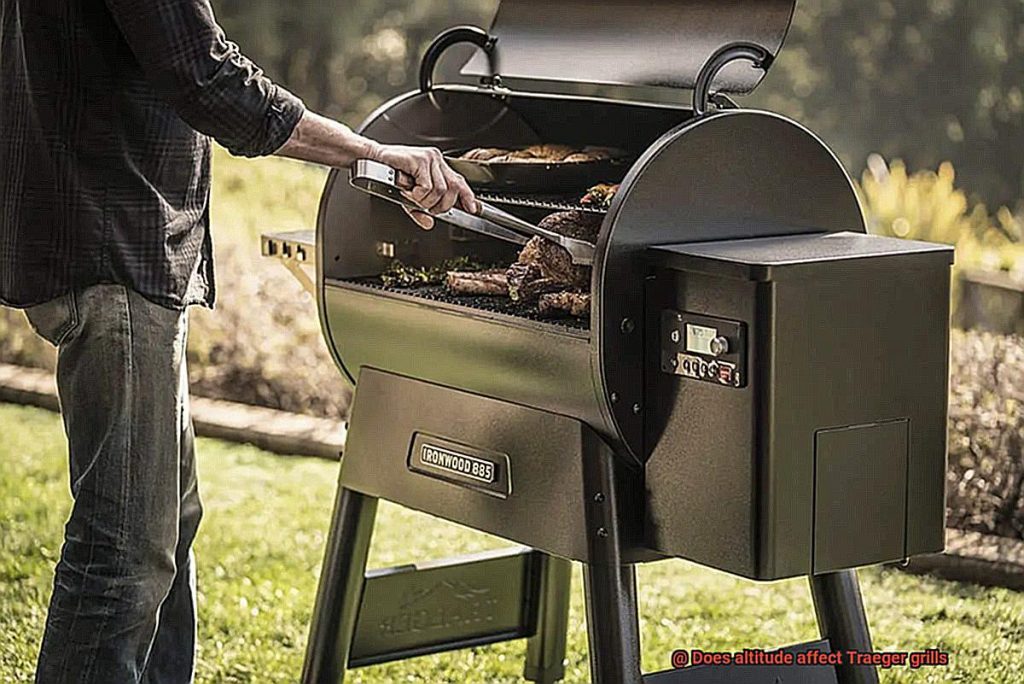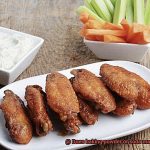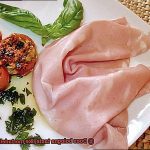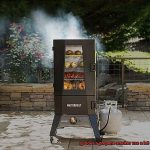If you’re a cooking enthusiast or a seasoned grill master, chances are you’ve heard of the incredible convenience and versatility of Traeger grills. These bad boys are designed to deliver mouthwatering, smoky flavors with minimal effort, earning them a well-deserved reputation for consistent performance. But here’s the thing – altitude can have a significant impact on your Traeger grilling experience. In this blog post, we’re diving into the nitty-gritty of how cooking at higher elevations affects Traeger grills, uncovering any notable differences from grilling at lower altitudes.
When you take your grilling game to new heights, you introduce a whole new set of variables that can mess with cooking times, temperature precision, and overall results. As you ascend, atmospheric pressure decreases, which directly messes with the boiling point of water and the evaporation rate within your grill. And let me tell you, that lower boiling point can seriously mess with flavor chemistry and throw off your cooking process.
Now, Traeger grills feature an automated control system that keeps temperatures steady while infusing that signature wood-fired taste into your food. But here’s the catch – this automated process needs precise adjustments based on altitude variations to maintain accurate temperature control and reliable cooking results. Ignoring these considerations could leave you with undercooked or overcooked dishes that taste all outta whack when you’re up in the mountains.
But wait, there’s more. Reduced oxygen levels at higher altitudes might just mess with the combustion process inside your grill too. To make sure everything burns efficiently and produces that tantalizing smoke we all crave, Traeger grills may require adjustments in airflow control. It’s all about ensuring optimal burning conditions so every bite is packed with flavor.
So buckle up as we explore the intricate relationship between altitude and Traeger grills. We’ll dive into the adjustments and techniques you need to conquer grilling challenges in those alpine settings. From modified temperature settings to accommodating variations in cooking times, we’ve got you covered. Our goal? To equip you with the know-how to master high-altitude grilling without compromising on taste or quality.
In the upcoming sections, we’re going deep into the influence of altitude on Traeger grills. We’ll break down all the technicalities while serving up practical tips and insights to help elevate your grilling game. So whether you’re
Contents
What is Altitude?
Altitude, the measurement of vertical distance above sea level, has a profound impact on various aspects of our lives. From influencing weather patterns to affecting human health, altitude plays a significant role. In this article, we will delve into the concept of altitude, its implications on Traeger grills, and provide strategies to overcome the challenges it presents for optimal grilling results.
Altitude and Atmospheric Factors:
Altitude directly affects atmospheric pressure and oxygen concentration. As one ascends higher, air pressure decreases, resulting in less dense air. This decrease also leads to a reduction in oxygen levels. These atmospheric factors have wide-ranging effects on both humans and machines.
The Impact on Traeger Grills:
At higher altitudes, the lower air pressure poses challenges for Traeger grills. The reduced air pressure affects temperature control and cooking times. Due to the decreased density of air, the temperature inside the grill drops, leading to longer preheating times and difficulties maintaining desired cooking temperatures.
Adjustments for Optimal Grilling:
To combat the lower air pressure at higher altitudes, it is crucial to make adjustments for optimal grilling with Traeger grills. It is generally recommended to increase the temperature setting by approximately 5 degrees Fahrenheit for every 1,000 feet above sea level. This adjustment helps compensate for the reduced air pressure and ensures that the grill reaches and maintains the desired cooking temperature more effectively.
Extended Cooking Times:
Lower air pressure at higher altitudes reduces heat transfer during cooking, resulting in potentially longer cooking times. It is essential to closely monitor the progress of food using a meat thermometer to ensure proper doneness.
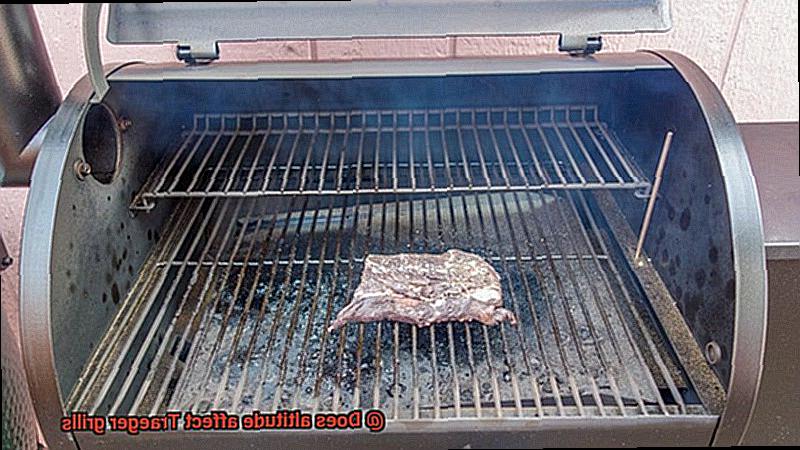
Retaining Moisture:
Higher altitudes often have drier air, which can lead to meat drying out during cooking. To prevent this, marinating or brining the meat before grilling can help retain moisture. Additionally, using a basting sauce during cooking can further enhance moisture retention.
How Does Altitude Affect Traeger Grills?
Join us as we explore the impact of altitude on our beloved Traeger grills. Like scaling a mountain, grilling at higher elevations presents unique challenges, but fear not. We’re here to equip you with expert knowledge and strategies to conquer these hurdles and continue grilling like a pro, no matter how high you go.
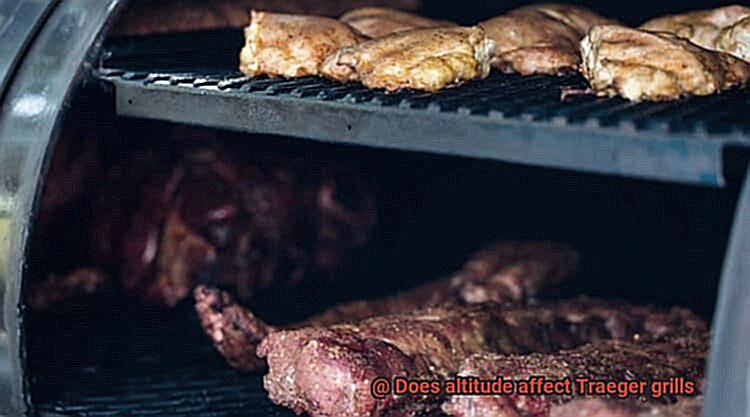
The Science Behind the Challenge:
Ascending to higher altitudes means encountering thinner air and reduced air pressure. This thin atmosphere affects the combustion process and temperature control of Traeger grills. The disrupted oxygen-to-fuel ratio inside the grill makes it harder to achieve efficient combustion and maintain consistent high temperatures.
The High Temperature Conundrum:
One primary challenge at higher altitudes is achieving and maintaining high temperatures. Reduced air pressure means it may take longer for your Traeger grill to reach the desired heat level. Don’t fret. Traeger recommends preheating your grill for a longer duration to compensate for lower heat output. This allows the grill to reach higher temperatures before adding your delectable food.
Even Heat Distribution:
Another hurdle at altitude is inconsistent heat distribution within the grill. Thinner air disrupts the flow of heat, resulting in uneven cooking. Some areas may cook faster or slower than others. Fear not. By rotating your food or using indirect cooking methods, you can ensure that every bite is cooked to perfection.
Strategies for Success:
To overcome these altitude-related challenges, Traeger provides expert tips:
- Increase Temperature Setting: Adjust your temperature setting slightly higher than usual to offset heat loss due to altitude.
- Adjust Cooking Times: Lower oxygen levels at higher altitudes can slow down cooking times. Keep a vigilant eye on your food and make necessary adjustments for thorough cooking.
- Preheat for Longer: Be patient and give your Traeger grill extra time to reach higher temperatures. This compensates for reduced heat output caused by thinner air.
- Monitor Closely: Pay close attention to the cooking process. Altitude may require more attention to prevent overcooking or burning your culinary creations.
Temperature Control and Cooking Times at Higher Altitudes
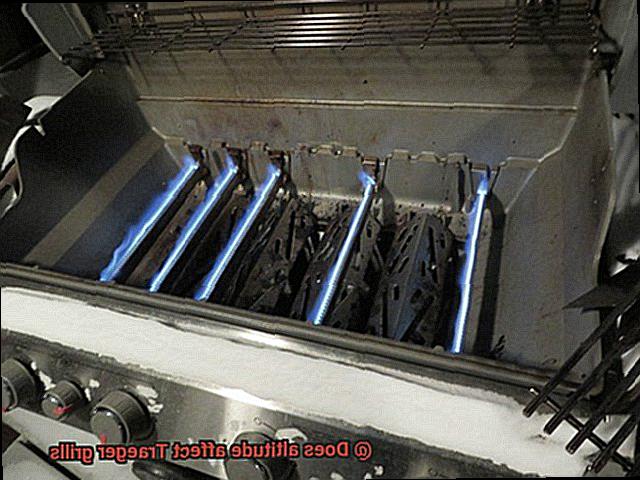
Imagine yourself on a breathtaking mountaintop, surrounded by majestic landscapes, ready to unleash your culinary prowess on your trusty Traeger grill. But wait, did you know that altitude can throw a curveball into your grilling game? Fear not, for we are here to guide you through the intricate dance between temperature control and cooking times at higher elevations. Get ready to conquer the challenges that come with cooking at the top of the world.
Understanding the Science:
- Boiling Point Blues: As you ascend to higher altitudes, the air pressure decreases, causing water’s boiling point to drop. This means that recipes involving boiling or simmering may require some adjustments to ensure that your dishes are cooked to perfection.
- Cooking Time Conundrum: The lower air pressure at higher altitudes also affects cooking times. With reduced pressure, foods may take longer to cook thoroughly, leaving you with undercooked meals if not managed correctly.
Traeger Grills and Altitude:
- Temperature Troubles: Due to the lower air pressure at higher altitudes, your Traeger grill might struggle to reach and maintain temperatures as effectively as it would at sea level. This can lead to longer cooking times and potentially undercooked food.
- Adjustments for Altitude: To combat the lower temperatures, Traeger grill enthusiasts in high-altitude regions should consider tweaking their cooking times or increasing the temperature setting on their grills. We highly recommend consulting the Traeger grilling guide or reaching out to customer support for altitude-specific recommendations.
- Trial and Error: Each recipe and food type may respond differently to altitude adjustments. Embrace some experimentation to find the optimal settings for your specific altitude, ensuring that every mouthful is a burst of flavor.
Adjusting the Temperature Setting on a Traeger Grill
Grilling at higher altitudes can be an exhilarating experience, but it poses its own set of challenges. One such challenge is adjusting the temperature setting on your Traeger grill to achieve culinary perfection. In this tutorial, we will explore the science behind altitude grilling and provide you with a step-by-step guide on how to adjust the temperature setting on your Traeger grill. Get ready to conquer the mountains and elevate your grilling game.
Understanding Altitude and Its Effects on Cooking:
Grilling at higher altitudes means dealing with lower air pressure, which impacts the boiling point of water and alters cooking times. To overcome this challenge, Traeger recommends adjusting the temperature setting on your grill by increasing it by 25 degrees Fahrenheit for every 3,000 feet above sea level.
Step-by-Step Guide to Adjusting the Temperature Setting:
- Consult your grill’s user manual or contact Traeger customer support for specific recommendations based on your grill model.
- Determine your altitude using a reliable source or an altimeter app on your smartphone.
- Calculate the temperature adjustment needed. Increase the temperature setting by 25 degrees Fahrenheit for every 3,000 feet above sea level.
- Locate the digital controller on your Traeger grill – usually found on the front control panel.
- To raise the temperature, press the “Up” or “+” button on the digital controller in 5-degree increments.
- To lower the temperature, press the “Down” or “-” button to decrease it in 5-degree increments.
- Allow a few minutes for your grill to reach and stabilize at the new temperature setting before placing your food on the grates.
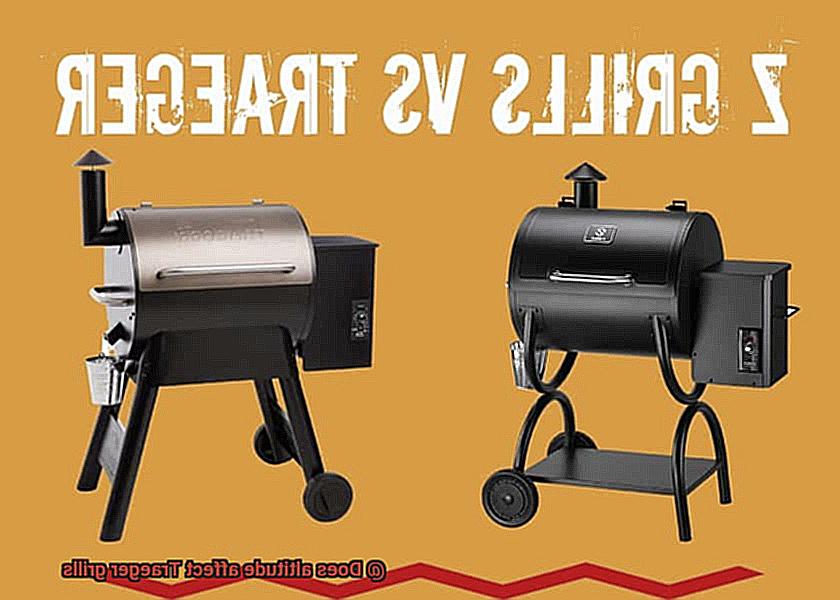
Additional Tips for Altitude Grilling Success:
- Use an instant-read meat thermometer to ensure your food reaches the desired internal temperature, especially at higher altitudes.
- Consider weather conditions, as they can affect cooking times and temperature stability.
- Experiment and adjust temperature settings based on personal preferences and the unique characteristics of your grill.
Extending Cooking Times at Higher Elevations
Cooking at higher elevations can take your grilling game to new heights, quite literally. However, it’s important to be aware of the challenges that come with it. The lower air pressure at higher elevations affects the boiling point of water, which in turn affects the cooking times of certain foods. But fear not, because with a few adjustments and techniques, you can conquer those obstacles and achieve delicious results on your Traeger grill.
To compensate for the longer cooking times at higher elevations, it is recommended to increase the temperature setting on your Traeger grill by 25 to 50 degrees Fahrenheit. This will help ensure that your food cooks thoroughly and reaches a safe level of doneness. It’s crucial to monitor the internal temperature of your food using a meat thermometer to make sure everything is cooked to perfection.
Different cuts of meat may require different cooking times, so be sure to adjust accordingly. Denser cuts like beef roasts or pork shoulders may need longer cooking times compared to thinner cuts like steaks or chicken breasts. Keep in mind that other factors such as wind and humidity can also influence cooking times at higher elevations. Wind can cause heat loss and evaporation, while high humidity can slow down the cooking process. So be mindful of these elements and make adjustments as needed.
The Impact of Moisture Content in the Air
The impact of moisture content in the air is a crucial factor to consider when it comes to grilling on Traeger grills. Whether you’re an experienced grill master or a novice looking to up your game, understanding how the air’s moisture affects your cooking can make all the difference between a dry, flavorless meal and a succulent, mouthwatering masterpiece.
Imagine this scenario: you’re nestled in the mountains, surrounded by crisp, fresh air and stunning vistas. It sounds idyllic, right? But here’s the catch – that thin mountain air can wreak havoc on your grilling plans. At higher altitudes, the air tends to be drier compared to your typical backyard grilling conditions. And this lack of moisture can spell trouble for your taste buds.
When there’s less moisture in the air, your food can dry out faster than you can say “pass the BBQ sauce.” The limited moisture leads to rapid evaporation of liquids from your food, resulting in dishes that are devoid of juiciness and flavor. No one wants a dry burger or a tasteless piece of chicken, right?
But fear not, my fellow grill enthusiasts. We’ve got some tricks up our sleeves to help you overcome this moisture conundrum. First and foremost, consider using marinades or brines to infuse your meat with much-needed moisture and flavor before it hits the grill. These magical concoctions have the power to transform even the driest cuts into succulent delights.
Basting is another technique that can work wonders. Simply brushing your food with a flavorful liquid during the cooking process helps maintain moisture levels and enhances taste. And for those who are serious about keeping things moist, incorporating a water pan into your grill setup can create a humid environment that ensures your food stays succulent throughout the cooking process.
Let’s not forget about our trusty meat thermometer, either. At high altitudes, cooking times can be a bit unpredictable, so it’s crucial to monitor the internal temperature of your food. No one wants an overcooked steak or undercooked chicken. So invest in a reliable meat thermometer and let it be your grilling sidekick.
Marinating or Brining Meat Before Grilling
Literally? Grilling at high altitudes can be a challenge, but fear not, because we’ve got the secret sauce for success. The key lies in marinating or brining your meats before they hit the grill. Trust us, this simple step will elevate your grilling experience and leave your taste buds begging for more.
Tenderize with Marination:
Marinating meat is like sending it on a rejuvenating spa retreat before it sizzles on the grill. The combination of herbs, spices, oils, and acids in the marinade works wonders, breaking down tough connective tissues and leaving you with melt-in-your-mouth tenderness. And let’s not forget about the explosion of flavors that will have your guests coming back for seconds. Pro tip: Add a touch of vinegar or citrus juice to your marinade for an extra punch of tenderizing power.
Boost Moisture with Brining:
Brining is like giving your meat a big, cozy hug before it faces the heat. By immersing it in a saltwater solution, you’re not only infusing it with savory goodness but also enhancing its ability to retain moisture. The magic happens when the saltwater seeps into the meat through osmosis, making it juicier and more succulent than ever. Say goodbye to dry and lackluster meats.
Taming the Altitude:
At high altitudes, the lower air pressure poses a challenge as moisture evaporates faster from your meats. But fret not. Marinating or brining your meats before grilling can deftly counteract this moisture loss. Not only do they add incredible flavors, but they also act as guardians of moisture, ensuring your meats stay lusciously succulent and bursting with taste.
Adjusting Recipes for Altitude:
When grilling at high altitudes, a few tweaks to your recipes are in order. The lower air pressure affects how flavors penetrate the meat. To achieve optimum flavor infusion, you might need to increase marinating time or adjust ingredient concentrations. Fear not, a little experimentation will pave the way to grilling perfection.
Timing is Everything:
When grilling at high altitudes, keep a vigilant eye on cooking times. The lower air pressure can throw off cooking temperatures and durations. Be prepared to extend cooking times or adjust heat levels to ensure your meat is cooked through and delectably safe.
Tips for Grilling Successfully at High Altitudes
Grilling at high altitudes can be a challenge due to the lower atmospheric pressure and thinner air. These factors affect the cooking process, resulting in longer cooking times and less heat retention.
The water in your food boils at a lower temperature, which means it may take longer for your burgers or hot dogs to reach that perfect level of doneness. Keep an eye on your food and be prepared to adjust the cooking time accordingly. Patience is key when grilling at high altitudes.
Heading: Preheat for Success
To ensure your grill reaches the right temperature, especially at high altitudes, it’s important to preheat it for an extended period of time. The thinner air can make it harder for your grill to get hot and stay hot. By giving it some extra time to heat up, you’ll be ready to go when it’s time to grill those juicy steaks or flavorful vegetables. Preheating is crucial for achieving evenly cooked and delicious results.
Heading: Monitor the Temperature
When grilling at high altitudes, it’s crucial to keep a close eye on the temperature of your grill. The thinner air can cause the temperature to fluctuate more quickly, so make sure you have a reliable thermometer on hand. This will help you accurately gauge the heat and make any necessary adjustments to keep your food cooking evenly. Monitoring the temperature throughout the grilling process is essential for achieving consistent results.
Heading: Check the Internal Temperature
Since cooking times may be longer at higher altitudes, using a meat thermometer is essential to ensure your food is cooked to perfection. The lower air pressure and thinner air mean you need to check the internal temperature of your meat regularly. This will help you avoid undercooked or overcooked dishes and guarantee that every bite is delicious. Don’t rely solely on cooking times; always use a meat thermometer to ensure food safety and optimal flavor.
Heading: Be Mindful of Windy Conditions
Grilling at high altitudes often means dealing with windy conditions. The wind can affect how heat is distributed and can impact your grilling process. To minimize its effects, consider using windbreaks or grilling in a sheltered area. By creating a protected grilling environment, you can ensure that your food cooks evenly and doesn’t get blown away. Be mindful of the wind direction and take precautions to shield your grill from strong gusts.
Heading: Patience is Key
When grilling at high altitudes, it’s important to be patient and allow for extra cooking time. The lower air pressure and thinner air mean it takes longer for heat to transfer to your food. Don’t rush the process. Take your time and let your grill work its magic. The result will be perfectly grilled dishes that are worth the wait. Embrace the slower cooking times as an opportunity to relax and enjoy the outdoor grilling experience.
Conclusion
In conclusion, altitude does indeed affect Traeger grills.
The higher you go, the lower the oxygen levels, which can impact the temperature and cooking times on your grill. At higher altitudes, it may take longer for your Traeger to reach the desired temperature and maintain it consistently.
However, with a little bit of experimentation and understanding of how altitude affects your grill, you can still achieve delicious results at any elevation.

